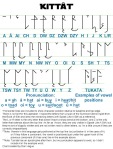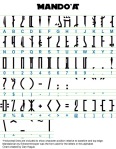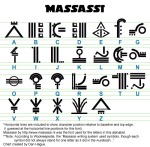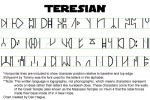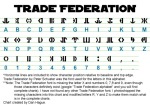UPDATE!: There has been a bunch of new information about the Kittât alphabet and Sith Language since I made these charts. Previously this post contained a highly incomplete chart of a Sith alphabet that didn’t have a name yet. Now that the full alphabet and its name are official, I have updated the chart for that alphabet! It is definitely my favorite alphabet, so I’m very excited that the full thing is here now. Now if only the language was fully fleshed out so this alphabet could really be put to use… The information for that language below has also been updated!
[EDIT]This post has been getting reblogged a ton lately, but without any of the text, which is a shame because I spent a lot of time typing it. Even more of a shame, the second post has been completely ignored. So because I took so much time making these charts and typing this text, I think I should add a link here to the other post, even though none of you will even see it.
Post 1 with the first 8 languages: http://lucif-hare.tumblr.com/post/17133571192/edit-this-post-has-been-getting-reblogged-a-ton[/EDIT]
For people who don’t like to scroll to find valuables, here is a link to download all of the Star Wars fonts I’ve found: http://freak-show.zxq.net/Star%20Wars%20Fonts.zip (Note: This is a zip file. You will need to unzip it.)
To install a font:
In Windows 7, open the font and there should be a button at the top that says “Install.” Click that and you’re done.
In other versions of Windows, copy and paste ONLY the font file into the font folder on your computer (It should be located in something like C:/Windows/Fonts)About these charts:
For whatever reason, I have a fascination with in-world Star Wars languages. I’ve spent countless hours searching the internet for different languages, namely for the written alphabets. What I’ve found is that, even for the languages that exist, it’s extremely hard to find charts or fonts for the written languages. Aurebesh is obviously easy to find, but the others, not so much.
Because it’s so hard to find charts, I decided to make my own. It took far longer than I expected it to, but I’m finally done.
I’ve managed to find 16 languages. I already posted the first 8 (in alphabetical order) in the last post, now it’s time for the last 8.
I’ve also gathered together all the Star Wars fonts I’ve found, including the fonts for each of the alphabets above (except for Geonosian, which was in the first post, and Kittât, which doesn’t have a font). A link to a zip folder with all of the languages can be found above. I should note that there are a lot of other Star Wars fonts out there, I was only looking for fonts for in-world languages. I just happened to have picked up some other English ones along the way.
About the languages:
Mando’a:
Mando’a is one of the most in-depth spoken languages that the Star Wars universe has (Click the Mando’a link above to see the entire language as it currently exists). Aside from the spoken language, there is also this written language. I’ve made the letters extra large to show off the tiny details in the letters (It’s probably good to note that the font seems to have had some errors with some of the letters, causing some of the shapes to look a little different (Specifically numbers 3 and 7). I’m not sure if that’s an issue with the way the font was designed or with Flash, the program I used to create these charts.) Because the characters have a lot of small nuances that relate more to line thickness than to the strokes, I haven’t yet figured out the best way to write this alphabet by hand. For instance, A and P would be hard to distinguish between if written by hand and E, J and I would also be hard to distinguish between.Massassi:
This was a very difficult font to find. I couldn’t find any instance of this written language anywhere on the internet except for the one single page that had this font for download (http://www.massassi.nl, the makers of the font). For some reason, the font displays strangely in Flash (looking closely, you can see white lines where the strokes of each character overlap). When I enlarged the font much larger, those white lines disappeared, but I had already made them pretty large. You’ll just have to try to ignore them, I guess…Anyway, according to Wookieepedia, the Massassi glyphs did not always represent a single letter.
When it comes to Massassi and things related to sith purebloods, there are a lot of similarities intentionally made to ancient Egypt (which is awesome, considering I’ve always had an intense fascination with ancient Egypt).
Nal-Huttese:
Nal-Huttese is another large spoken language that you can learn (Click the Nal-Huttese link to view the list of words). As for the written alphabet, Huttese comes in two flavors. Nal-Huttese is the main alphabet used to write Huttese. The other is Trade Huttese (which we’ll get to below).Nal-Huttese is another alphabet that I think would be difficult to write by hand. It’s obviously a very calligraphic alphabet. It does look cool, but due to how difficult it’d be to write this alphabet in a recognizable way, it’s not one of my priorities to learn this alphabet, though I still plan to get to it eventually.
Teresian:
Teresian is a written language based in glyphs. According to Tommy, the creator of this font, the characters were taken from the walls of an ancient sith temple called the Great Temple (also known as Massassi Temple) on Yavin 4, where the rebel forces made their base in A New Hope. Tommy also says that the Star Wars comic books call this glyph language Teresian. I have no idea what Teresian is or what species it is associated with, a Wookieepedia search and a Google search turn up zero results. Tommy also didn’t say which comic it’s from, so I couldn’t even attempt to look it up. That said, this temple was constructed by Massassi to worship the sith lord Naga Sadow, which means that if all of the above information is true, then this glyph set is another Massassi glyph language. I don’t know if that means that this is just more letters from the Massassi written language or if they had two different glyph languages or what…The font itself is named SWyavin4. SW obviously stands for Star Wars and Yavin 4 is the location of this temple where the glyphs were found. Aside from all of this, these glyphs do not correspond to letters of an alphabet which means they are logographic and represent words and ideas instead.
Trade Federation:
A note from the creator of this font:I discovered these characters on the official Star Wars website. You can find them on their new feature, the Droid Viewer. All characters are cannon as far as I could decipher them. They are pretty small. I was not able to find an X yet, but I will update the file as soon as possible.
I called it the Trade Federation Font, cause this interactive feature is called “Federation Droid Viewer”. I also noticed, that there are several characters that are the same as in the “Droids” font.Please note that the font is missing the letter X and numbers 0, 7, 8 and 9. To create the chart above, I cut up other letters to create the missing characters using a complete chart found on Wookieepedia. I have no idea why this font hasn’t been updated to fill in the missing letters. Also note that I modified letters R, Y and Z to match the chart on Wookieepedia. The actual font for those 3 letters looks slightly different.
Trade Huttese:
Trade Huttese is the second alphabet used to write Huttese. It is used primarily for trade with people from off world.from a source sent by Mike Dolan from Star Wars Insider Magazine #35, Winter 1997. Article: “Making Special Edition Collectibles – A Talk with Designer Eric Larson”, pages 63-67. The single picture appears on page 65.
Relevant quotes: “I created some boxes for Pizza Hut…I then created “Jabba’s Alphabet.” Years ago at a World con, I got to work for Howard Kazanjian, the producer of Jedi and Raiders. We had to put the frozen Han Solo and speeder bike together for the exhibit, and while doing so I noticed the writing on the props. I asked Howard what it was and he told me it was Hebrew, so when I designed Jabba’s alphabet I used a modern Hebrew font as a model.“ – from Designer Eric Larson.
Mike Dolan and I feel than since nothing is made for StarWars without the OK of Lucas & Co., this is as canon as Trade Huttese will get.Kittât:
This alphabet is by far my favorite of all Star Wars alphabets. It doesn’t look anything like any real world alphabet I’ve ever seen (Look at my previous post at the Common Sith info to see how important that is to me, haha). I really like the way this alphabet looks and how it works. Something about it really reminds me of demonic sigils, which I think is extremely fitting for a written alphabet for ancient sith.There are only two sources that I am aware of that feature Kittât at all. One of them is the Book of Sith, which has a spell called Dwomutsiqsa (Summon Demon) that is written in Kittât. I traced the letters from a scan of that image in order to get the most accurate possible letters for my chart. This spell can be seen on the Sith language page, which is full of lots of great information about the language. This spell only contains a small portion of the full Kittât alphabet.
The second source that features Kittât is from a brief 4 page article that was featured in Star Wars Insider Issue 134 called Speak Like A Sith, written by Kittât’s creator, Ben Grossblatt. The final page features an illustration showing the entire Kittât alphabet, which can be seen on the Kittât page, however it has a much sloppier style than is seen in the Dwomutsiqsa spell. This made it hard to discern the exact shape and size of a few of the letters (especially the letter for L or R and Z. The L or R letter is the only letter that doesn’t have a sharp bend at the bottom, which makes it hard to know where the bottom of it is and how far, if it all, the bottom curve extends below the baseline. Z is the only letter that extends above the top line. Like L/R, this makes it seem like I’m not interpreting it correctly, or that the sloppy writing style has made it appear to be shaped differently than it is supposed to be. It doesn’t help that several other letters differ a lot from how they look in the Dwomutsiqsa spell, like the bottom curve of any letter with Y in it, for example. For both the L/R letter and Z, it’s also hard to tell if the lines are meant to be curved or straight. Do they appear curved because it’s sloppy handwriting? Or do they appear straighter for that reason? All I can say is that I did my best to match the illustration.
The way this alphabet works is that all vowels are diacritics (a small mark added in or around another letter) that are placed at the top line or just under the hook of the previous consonant (if it has one on the top). You can see an example of this in the bottom right corner of the chart.
There are some important things to note about this alphabet. The first thing one might notice is that several English letters are missing. Unfortunately this alphabet just doesn’t have them, by design. Kittât’s creator, Ben Grossblatt, said the following in Speak Like A Sith:
I like to think creative Sith scribes would translate [Palpatine’s] name into their own language.
This means it will be very difficult to use this alphabet without learning the Sith language, which is difficult on its own due to there currently being such a limited vocabulary available. I’m dying to use this alphabet (and the Sith language) in day to day, casual settings, so I seriously hope the language gets fleshed out fully and very soon.
NOTE: This font was previously named Boonta after the festival it is seen in, but we renamed it Veknoid because Mike Dolan found out that the Boonta festival & Pod races seem to be inspired by the Veknoid aliens. The Veknoid [Boonta] symbols are visible on the Racing Pod of Teemto Pagalies (A furry, Bulldog-faced being) in the Incredible Cross-Sections Book. Teemto has been identified as a Veknoid, another species famous for having many members who are Podracers.
This font only has letters A-J, which makes it rather useless. It looks pretty cool, though.
- Comment
- Reblog
-
Subscribe
Subscribed
Already have a WordPress.com account? Log in now.
